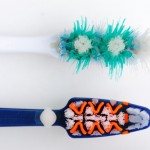
Good oral hygiene is important for maintaining oral health and preventing caries and periodontal diseases. Twice daily toothbrushing with a fluoridated toothpaste is recommended with manual toothbrushes continuing to play a major role in removing plaque although powered toothbrushes reduce plaque and gingivitis slightly more than manual toothbrushes. Replacing manual toothbrushes at 3-4 months is generally recommended but studies on the ability of worn toothbrushes to remove plaque are conflicting and wear is significantly impacted by individual habits.
The aim of this review was to compare the anti-plaque and anti-gingivitis efficacy of new and worn manual brushes.
Methods
The study protocol was registered in the International Prospective Register of Systematic Reviews (PROSPERO) database. Searches were conducted in the Cochrane Central Register of Controlled Trials (CENTRAL), Medline/PubMed, Embase, Scopus and Web of Science, Google Scholar and Clinicaltrials.gov databases with no date of language restrictions. This was supplements by hand searches of the journals, International Journal of Dental hygiene, Journal of Periodontology, Journal of Clinical Periodontology from 2010 to 2022.Randomised controlled trials (RCTs) in patients of 18 years of age with any periodontal diagnosis involving manual toothbrushes with a minimum duration of 1 month were considered. Two reviewers independently selected studies, extracted data and assessed risk of bias using the revised Cochrane Risk of Bias tool (RoB 2.0) Meta-analyses were performed comparing the toothbrushes after a single use (anti-plaque efficacy) and after multiple uses (anti-plaque and anti-gingivitis efficacy).
Results
- 8 RCTs (5 parallel, 2 cross-over,1 split-mouth) involving a total of 344 patients were included.
- 4 of the studies were single-use experiments and 4 multiple use.
- None of the studies clearly reported periodontal diagnosis at inclusion.
- Follow-up time ranged from 2 weeks to 6 months.
- 2 studies were considered to have a high risk of bias and 6 studies some concerns.
- Meta-analysis of 4 single-use studies found no statistically significant difference between groups new and worn toothbrushes for anti-plaque efficacy, standard mean difference (SMD) = −0.39 (95%CI: −0.80 to 0.03).
- Meta-analyses of multiple use studies found
- a significantly higher reduction of dental plaque with new toothbrushes group, SMD= −0.75 (95%CI: −1.37 to −0.14) [ 4 studies].
- no difference between new and worn toothbrushes for anti-gingivitis efficacy, mean difference (MD) = −0.10 (95%CI: −0.24 – 0.03) [ 2 studies].
- The overall certainty of the evidence ranged from very low to low.
Conclusions
The authors concluded: –
…both new and worn toothbrushes presented similar anti-plaque and anti-gingivitis efficacy. Bristle wear may be the most important factor to indicate the replacement of a toothbrush.
Comments
While twice daily toothbrushing with a fluoride toothpaste is highly recommended and well evidence intervention there an many factors that might influence both the effectiveness of toothbrushing and toothbrush wear. These include toothbrush techniques, force applied, duration of brushing, type and design of toothbrush and type of toothpaste. (Dental Elf – 11th Aug 2014).
This review looks at the impact of one element, the wear state of the toothbrush suggesting that there is little difference between new and worn brushes. However, only a small number of studies are included and none of them were at low risk of bias. In addition, 4 of the 8 included studies were single brushing episode studies which has implication when considering longer term effects. The authors note that most of the included studies did not provide any specific oral hygiene instructions. Effective oral hygiene measures are difficult to perform requiring many complex hand movement and more research is needed to understand the most effective methods, brushes , other adjuncts and methods of delivering and maintain the use of effective approaches.
Links
Primary Paper
Silva FH, Montagner AF, Silveira MC, Muniz FWMG. Anti-plaque and anti-gingivitis efficacy of new and worn manual toothbrushes: A systematic review and meta-analysis. Int J Dent Hyg. 2022 Oct 27. doi: 10.1111/idh.12640. Epub ahead of print. PMID: 36300684.
Other references
Dental Elf – 7th Jul 2017
Dental Elf – 27th Jun 2016
Dental Elf – 27th May 2015
Dental Elf – 11th Aug 2014
